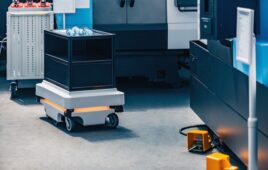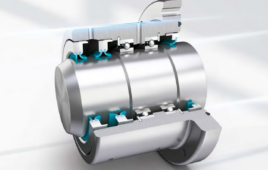Application of high temperature quartz oscillators in oil, gas, and geo-thermal exploration has been the subject of increasing discussion in recent years. The need for these devices, and high temperature electronics in general, has arisen from application requirements that have pushed the upper temperature range limit higher.
The largest market segment within the field of high-temperature electronics is drilling for oil, gas, and geo-thermal exploration. This field is generally divided into two categories, the first being down hole drilling and the second being horizontal drilling. As implied by the name, down hole drilling refers to drilling down to a certain depth from the surface of the earth. Horizontal drilling refers to drilling to a certain depth, followed by drilling horizontally at that depth in parallel to the surface of the earth in search of oil, gas, or other minerals. It also facilitates a trench-less method for installing infrastructure such as telecommunications, power, water, sewer, gas, oil, product pipelines, and environmental remediation casings.
The size of this market has historically fluctuated with the price of oil. The reason is that higher oil prices provide an incentive for companies to increase their design and construction work on oil and gas exploration platforms.

Instruments used for oil and gas exploration originally had an operating temperature requirement of 150°C. Over the years, instruments have needed to be designed that are capable of drilling in increasing depths into the earth in search of oil and gas. These instruments therefore required the use of oscillators that were able to operate at increasing temperatures, first to 175°C, and subsequently to 200°C. As of the writing of this piece, 200°C is a standard operating temperature for down hole applications, and discussion of higher operation temperatures such as 220°C and 240°C has started.
Although some high temperature devices have been available in the market in the past, historically this field has been limited due to the lack of commercially available components designed to operate reliably above 125°C, lack of capital equipment for fabrication and specialization test facilities to build high temperature electronics, immaturity of certain required material technologies and processes, shortage of high volume applications willing to help fund the expense of new device development, and some applications requiring demonstrated reliability of high temperature electronics that justifies the higher cost of these devices. In recent years, many of these limitations have been removed as high temperature electronics has been demonstrated to work reliably in a number of extreme environments.
Specifically, some of the challenges that need to be dealt with in designing oscillators that are required to work at high temperatures are as follows.
1. The design of low frequency high temperature oscillators is different than the design of high frequency high temperature oscillators.
2. Aging is known to accelerate at high temperatures. Studies have been performed to determine the extent to which the aging of an oscillator accelerates when subjected to high temperature operation. These studies include the identification of materials and process techniques that can reduce the aging rate.
3. Length of operation: High temperature oscillators typically guarantee operation for 1,000 hours at 200°C.
4. How are various parameters of the oscillator such as frequency, current, rise time, fall time, and duty cycle effected under high temperature operation? In performing these measurements, it is important to understand the load that the oscillator will be driving in the circuit. Overloading can cause higher current consumption and degradation of waveform parameters such as rise time, fall time, duty cycle, and the input high voltage (VIH).
5. What type of termination and solder are best for customers of high temperature oscillators to use. Also, what type of materials (such as epoxies) are best to be used in oscillators that are required to operate in temperatures of 200°C and higher.
Recent developments have concentrated on meeting these challenges, and have yielded high temperature oscillators that can not only reliably operate at higher temperatures, but also devices that feature improved longevity and lower operating voltages, as well as devices that are offered in new packages.
For example, Statek currently offers high-temperature oscillators in three packages: The CXOHT, the CXOMHT, and the CXOXHT. These oscillators offer significant advantages such as achieving 5,000 hours of (typical) operation at 200°C, aging of less than 60 ppm after 1,000 hours of operation, and excellent shock survival (3,000 g – 5,000 g depending on the package size).
Because instruments used in oil, gas, and geo-thermal exploration are used in increasing depths, they are subject to shock and vibration, both during lowering the instrument down the hole, and when bringing it back up to the surface of the earth. (Statek offers high-shock versions of all three high temperature oscillators listed above). Experience has shown that these instruments are also subject to pieces of rock or other foreign objects falling on them while operating deep inside the earth. In order to minimize the effects of the high-temperature oscillator being exposed to the outside environment, electronic engineers designing circuits using these oscillators would do well to place the printed circuit board inside a robust enclosure, and manufacturing engineers would do well to ensure that all pads of the oscillator make a good, stable mechanical connection to the board when the printed circuit board is being manufactured. Lastly, specifying the appropriate solder composition or bonding agent is vital to a robust design.
Filed Under: Industrial automation




